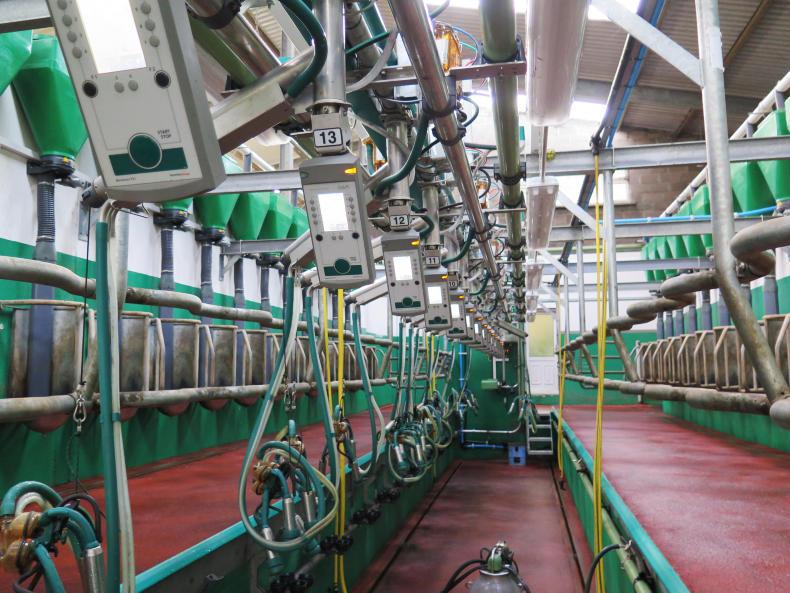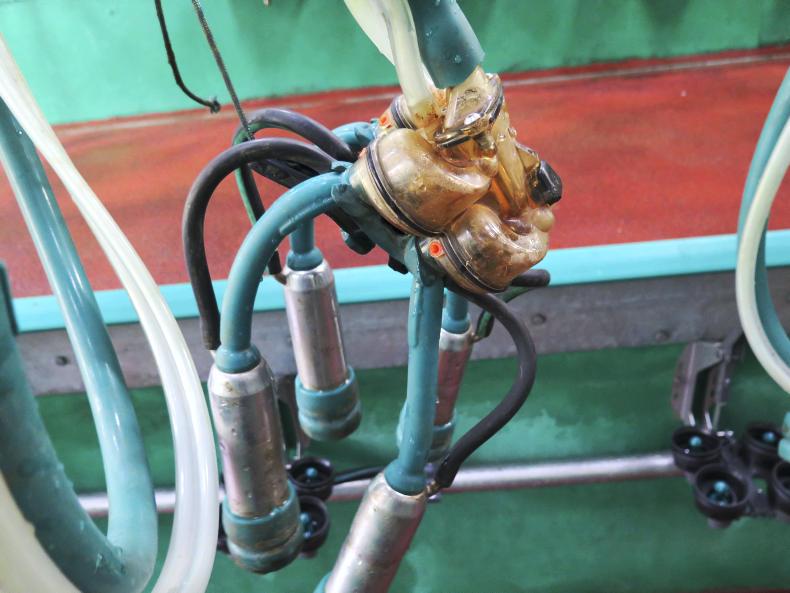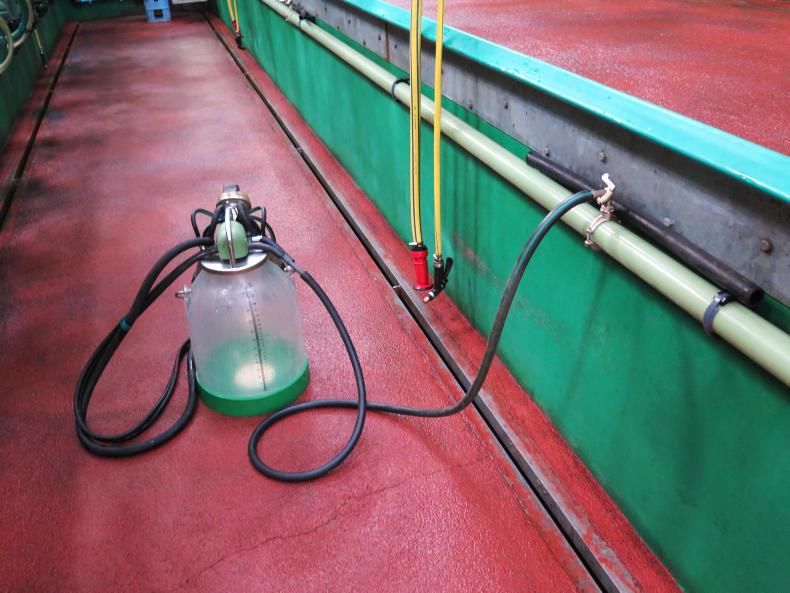Liam Kelleher’s old eight-unit parlour had served him well for many years but, with cow numbers increasing, he needed something more efficient.
What he got was a state-of-the-art GEA milking machine.
Now milking only takes him about 45 minutes and cow numbers have increased from 100 three years ago, to 150 for the coming season.
Liam is farming with his family on a picturesque farm overlooking the River Bandon between Kinsale and Innishannon.
The new parlour was commissioned in August 2015. When the Irish Farmers Journal visited the farm last week, Liam was getting ready for the evening milking.
This will be his last year milking through winter as herd fertility has improved and calving is now more compact.
When he was planning the parlour he wanted something that was going to reduce the time spent milking but also to use available technology to reduce the labour required for other jobs.
The new machine has a high level of technology including automatic identification, milk meters, automatic cluster removers, automatic washing, heat detection, automatic drafting and feed to yield meal feeding.
Greenfield site
The parlour was constructed on a greenfield site just at the back of the old parlour and in between two cubicle sheds.
Cows come in from the fields or sheds at the back and exit by turning right and going down through the drafting gate and passing the crush area. Over the dairy is a spacious office area looking down into the parlour.
The machine was supplied and installed by GEA distributors Charleville Refrigeration. GEA is the company that owns the Westfalia and Milfos brands of parlours.

Most GEA rotary installations in Ireland are Milfos, while herringbone and robotic machines tend to be Westfalia branded.
Liam opted for a 20-unit with space at the back for four more units.
The first thing that you notice with a GEA parlour is the looped vacuum and milk lines.
Liam explained the looped system means vacuum is equalised throughout the plant, much like in a looped water system.
Vacuum running pressure is 45Kpa, which is lower than most other milking machines. Every second unit is plumbed into each side of the 70mm milk line and 90mm vacuum line.
Claw piece
The other striking thing about the plant is the claw piece. Unlike most other claw pieces with one chamber and four liners feeding into it, the GEA claw piece has four independent chambers and is nearly all plastic.
There is a little steel ball in each chamber that blocks the vacuum from escaping until such time as the top of the milk liner comes in contact with a teat.
The differential of pressure which occurs on contact with another object, whether it is a cow’s teat or your finger, causes the steel ball to instantly pop out and full vacuum is restored.

There are no mechanics or electronics involved, it is simply the difference in pressure upon contact that causes the ball to pop out.
As soon as contact is removed the ball immediately pops back in again with no air entering.
The other thing you notice is that the short pulse tubes are located in between the left and the right milk liners.
On most other machines, the short tubes are to the side of the claw piece in between the front and back liners.
“Because the short tubes are tucked inside the liners, heifers aren’t able to kick the units off.
"It’s also a very light clawpiece which is easier to work and because there is no vacuum being lost from the cups I often put on two cups at a time, particularly when cows are at peak and it’s easy to get at the teats."
It also means I don’t have any dummy teats for cows with three teats.
Instead of a dump line being installed, Liam opted for an independent vacuum line. This line is positioned on the right-hand side of the pit and all Liam has to do is connect his bucket plant on to this at any point down along the line.
The auto ID system prevents a cow whose milk is withheld from being milked. Liam has three buckets but he only uses one most of the time. All the liners and milk tubes used in the plant are silicon.

The pulsation system is 2x2 as standard on all GEA plants. Cows are standing at 800mm centres, which is 2ft 7.5in.
This is slightly wider than the 2ft 6in that most herringbones in Ireland are at. The stallwork has a double zig zag rump rail.
Meal is fed in individual steel troughs. All the stallwork is manufactured and supplied by GEA in Germany. The only item not supplied by GEA is the auger for the meal feeders.
Liam says he doesn’t make much use of the feed-to-yield system.
“On grass-based spring-calving farms like my own they don’t add much, especially where not a whole lot of meal is being fed. I usually just feed at a flat rate,” Liam says.
Each cow is identified when she comes in for milking. Heat detection is done through neck collars. Liam is 100% reliant on the neck collars to pick up cows in heat, so much so that he no longer uses tail paint.
Cows in heat are automatically drafted and Liam does the AI himself.
Somatic cell count is excellent at between 70,000 and 80,000 all year. TBC is similarly good at between 3,000 and 4,000. Liam only uses teat spray when cows are inside on cubicles, opting for the handheld sprayer rather than drop-down hoses.
Air-operated gates
The milking pit is 1.8m wide. The front and back gates are air-operated. The back gates close automatically as soon as 20 cows are in.
The gates are operated from anywhere in the pit by pressing a button on the control panel. This panel also displays the cow’s milk yield relative to what she is expected to give based on her production history.
Small jars are used when milk recording to collect and agitate a sample of milk from each cow.
Before I left, I asked Liam if there was anything he would have done differently if he was starting out again.
He said that the only thing he’d change is to put in the extra four units on day one.
According to Charleville Refrigeration, for a high-spec parlour like Liam has, you would be talking about a price in the region of €7,000 to €8,000 per unit plus VAT.
This is for all the milking components including loop milk and vacuum line, clusters and all the automation including heat detection. The shed and building costs, along with electricity and plumbing are on top of this price.
Comment
The price per unit of a hi-tech milking parlour like Liam’s is more than twice that of a basic plant with little or no automation.
Whether that extra investment is worth the money is based on personal preferences, business goals and how much you value time and labour.
For well-established owner operators such as Liam, it’s hard to argue with having a system in place that allows for one man to operate a 150-cow farm with minimal stress.
Of course, having good milking facilities is just one element of this.
Read more
The correct milking technique - from start to finish
Preparing for a calving storm in Kilkenny
Liam Kelleher’s old eight-unit parlour had served him well for many years but, with cow numbers increasing, he needed something more efficient.
What he got was a state-of-the-art GEA milking machine.
Now milking only takes him about 45 minutes and cow numbers have increased from 100 three years ago, to 150 for the coming season.
Liam is farming with his family on a picturesque farm overlooking the River Bandon between Kinsale and Innishannon.
The new parlour was commissioned in August 2015. When the Irish Farmers Journal visited the farm last week, Liam was getting ready for the evening milking.
This will be his last year milking through winter as herd fertility has improved and calving is now more compact.
When he was planning the parlour he wanted something that was going to reduce the time spent milking but also to use available technology to reduce the labour required for other jobs.
The new machine has a high level of technology including automatic identification, milk meters, automatic cluster removers, automatic washing, heat detection, automatic drafting and feed to yield meal feeding.
Greenfield site
The parlour was constructed on a greenfield site just at the back of the old parlour and in between two cubicle sheds.
Cows come in from the fields or sheds at the back and exit by turning right and going down through the drafting gate and passing the crush area. Over the dairy is a spacious office area looking down into the parlour.
The machine was supplied and installed by GEA distributors Charleville Refrigeration. GEA is the company that owns the Westfalia and Milfos brands of parlours.

Most GEA rotary installations in Ireland are Milfos, while herringbone and robotic machines tend to be Westfalia branded.
Liam opted for a 20-unit with space at the back for four more units.
The first thing that you notice with a GEA parlour is the looped vacuum and milk lines.
Liam explained the looped system means vacuum is equalised throughout the plant, much like in a looped water system.
Vacuum running pressure is 45Kpa, which is lower than most other milking machines. Every second unit is plumbed into each side of the 70mm milk line and 90mm vacuum line.
Claw piece
The other striking thing about the plant is the claw piece. Unlike most other claw pieces with one chamber and four liners feeding into it, the GEA claw piece has four independent chambers and is nearly all plastic.
There is a little steel ball in each chamber that blocks the vacuum from escaping until such time as the top of the milk liner comes in contact with a teat.
The differential of pressure which occurs on contact with another object, whether it is a cow’s teat or your finger, causes the steel ball to instantly pop out and full vacuum is restored.

There are no mechanics or electronics involved, it is simply the difference in pressure upon contact that causes the ball to pop out.
As soon as contact is removed the ball immediately pops back in again with no air entering.
The other thing you notice is that the short pulse tubes are located in between the left and the right milk liners.
On most other machines, the short tubes are to the side of the claw piece in between the front and back liners.
“Because the short tubes are tucked inside the liners, heifers aren’t able to kick the units off.
"It’s also a very light clawpiece which is easier to work and because there is no vacuum being lost from the cups I often put on two cups at a time, particularly when cows are at peak and it’s easy to get at the teats."
It also means I don’t have any dummy teats for cows with three teats.
Instead of a dump line being installed, Liam opted for an independent vacuum line. This line is positioned on the right-hand side of the pit and all Liam has to do is connect his bucket plant on to this at any point down along the line.
The auto ID system prevents a cow whose milk is withheld from being milked. Liam has three buckets but he only uses one most of the time. All the liners and milk tubes used in the plant are silicon.

The pulsation system is 2x2 as standard on all GEA plants. Cows are standing at 800mm centres, which is 2ft 7.5in.
This is slightly wider than the 2ft 6in that most herringbones in Ireland are at. The stallwork has a double zig zag rump rail.
Meal is fed in individual steel troughs. All the stallwork is manufactured and supplied by GEA in Germany. The only item not supplied by GEA is the auger for the meal feeders.
Liam says he doesn’t make much use of the feed-to-yield system.
“On grass-based spring-calving farms like my own they don’t add much, especially where not a whole lot of meal is being fed. I usually just feed at a flat rate,” Liam says.
Each cow is identified when she comes in for milking. Heat detection is done through neck collars. Liam is 100% reliant on the neck collars to pick up cows in heat, so much so that he no longer uses tail paint.
Cows in heat are automatically drafted and Liam does the AI himself.
Somatic cell count is excellent at between 70,000 and 80,000 all year. TBC is similarly good at between 3,000 and 4,000. Liam only uses teat spray when cows are inside on cubicles, opting for the handheld sprayer rather than drop-down hoses.
Air-operated gates
The milking pit is 1.8m wide. The front and back gates are air-operated. The back gates close automatically as soon as 20 cows are in.
The gates are operated from anywhere in the pit by pressing a button on the control panel. This panel also displays the cow’s milk yield relative to what she is expected to give based on her production history.
Small jars are used when milk recording to collect and agitate a sample of milk from each cow.
Before I left, I asked Liam if there was anything he would have done differently if he was starting out again.
He said that the only thing he’d change is to put in the extra four units on day one.
According to Charleville Refrigeration, for a high-spec parlour like Liam has, you would be talking about a price in the region of €7,000 to €8,000 per unit plus VAT.
This is for all the milking components including loop milk and vacuum line, clusters and all the automation including heat detection. The shed and building costs, along with electricity and plumbing are on top of this price.
Comment
The price per unit of a hi-tech milking parlour like Liam’s is more than twice that of a basic plant with little or no automation.
Whether that extra investment is worth the money is based on personal preferences, business goals and how much you value time and labour.
For well-established owner operators such as Liam, it’s hard to argue with having a system in place that allows for one man to operate a 150-cow farm with minimal stress.
Of course, having good milking facilities is just one element of this.
Read more
The correct milking technique - from start to finish
Preparing for a calving storm in Kilkenny









 This is a subscriber-only article
This is a subscriber-only article











SHARING OPTIONS: